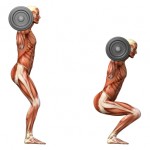We recently received an email from an individual inquiring about struggling with weight. Here is the email:
I have been struggling with my weight since I was 9. I am now 47 and I have tried every diet on the planet, I have tried exercise, I have tried meal plans and just about everything else.
A few times I have lost weight only to put it back on again. I heard about your weight loss program from a friend of mine and I was wondering if you could provide me with some guidance on what I can do about my weight.
V.S. Calgary
Dear V.S.,
I sympathize with your situation; losing weight can be a very difficult and frustrating experience. Unfortunately, many of the popular approaches to weight loss provide only a short term benefit – if they help at all – where a person may lose some weight for a brief period of time, only to gain it back again a short while later. Because the current approaches to weight loss are so unsuccessful at helping people lose weight, it is my contention that a new approach to weight loss is required, one that is not too cumbersome or oppressive to implement and, in particular, one that will lead to permanent weight loss.
sympathize with your situation; losing weight can be a very difficult and frustrating experience. Unfortunately, many of the popular approaches to weight loss provide only a short term benefit – if they help at all – where a person may lose some weight for a brief period of time, only to gain it back again a short while later. Because the current approaches to weight loss are so unsuccessful at helping people lose weight, it is my contention that a new approach to weight loss is required, one that is not too cumbersome or oppressive to implement and, in particular, one that will lead to permanent weight loss.
You may be interested in attending our weight loss information session being held on November the 16th at Preventous Collaborative Health. The session runs from 6:30 – 8:00 PM. In this session I will talk briefly about the challenges facing people trying to lose weight and I will also provide an introduction to a model I am employing at Preventous to help people lose excess weight and keep it off permanently. To know more please call us at Preventous at 403.229.0129.
Talk about conflicting advice. Squats are the most commonly used exercise in strength and conditioning programs for sports performance, occupational tasks and daily living. Yet some people will tell you they’re dangerous and to stay away from them. What should you believe?
 Debunking the Myths
Debunking the Myths
The problem can be traced back to the 1960s when Karl Klein, an oft-published professor, claimed that performing full (below parallel) squats was dangerous and damaging to the knee. But over the years, the field of exercise science has developed along with its research. And it turns out that Klein was wrong.
While some people may experience pain when learning to squat, this is not a telltale sign that damage is being done. What the pain really means is that either the technique is incorrect or there is an issue with joint flexibility.
Contrary to Klein’s belief, current research supports training programs involving full squats. Squatting below parallel strengthens the ligaments of the knee, decreases joint laxity and decreases contact pressure at the joint. In fact, the greatest pressure at the knee occurs at an 80- to 90-degree bend.
Perfect Your Technique
When performing a squat there are four important factors to consider: stance width, weight distribution on the foot, forward movement of the knee and backward movement of the hip.
A narrow squat stance (feet hip-width apart) allows the knees to move forward and decreases backwards movement of the hips, placing the weight in the centre of the foot. This stance evenly distributes the effort of the hip, knee and ankle musculature for safe and efficient movement.
A wide squat stance (feet greater than hip-width apart) will have less forward knee movement resulting in a greater backward shift of the hips, placing the weight distribution in the heel. This stance reduces the amount of ankle bend and consequently increases the demands on the hip and knee. The wide squat stance often results in increased contact pressure at the knee joint and inner knee strain, often associated with injuries.
Simply put, if squats are causing you pain you have to address the problem. A certified kinesiologist will be able to assess flexibility along with muscle weaknesses and/or imbalances, and will teach you the proper technique. The result will be stronger hips, knees and ankles, without worrying about injury.
We know that eating green is good for us. But did you know that eating orange is as well? Of course, we don’t mean orange-hued leftover Halloween candy. But eating the right orange foods can give you many health benefits.
 Orange veggies and fruits get their bright colour from beta-carotene, a powerful anti-oxidant that may reduce your risk of heart disease and many types of cancer. Remember that antioxidants help protect all cells from radical damage that occurs with exposure to pollutants, UV rays, aging and general metabolic processes.
Orange veggies and fruits get their bright colour from beta-carotene, a powerful anti-oxidant that may reduce your risk of heart disease and many types of cancer. Remember that antioxidants help protect all cells from radical damage that occurs with exposure to pollutants, UV rays, aging and general metabolic processes.
Your body also uses beta-carotene to produce vitamin A, essential for healthy vision, immune function, and regulation of cell growth. And potassium from orange veggies is important for nerve and cell function, as well as regulation of blood pressure.
Does this means that it is time to stock up on baby carrots? Sure, but there are many other options too. Feel free to explore the fall bounty of squashes, pumpkins, orange bell peppers and sweet potatoes. Alternatively, mix it up with apricots, nectarines, papayas, peaches and mangoes, though these may not be in season.
Pumpkin Pie Oatmeal Recipe
Ingredients:
- Ingredients:
- 3 cups water
- 3 cups low-fat milk
- 3 cups raw pumpkin (cut into 1-inch cubes)
- 1 1/2 cups steel cut oats
- 1/2 cup honey
- 1 tsp ground cinnamon
- 1/4 tsp ground nutmeg
- ½ tsp table salt
- ½ cup walnut pieces
Instructions:
Set aside walnut pieces. Combine the rest of the ingredients in a 3- to 6-quart slow cooker; stir well. Cook, covered, on low setting for 7-9 hours; stir well before serving. Top each bowl with walnuts. Makes 4 individual servings.
